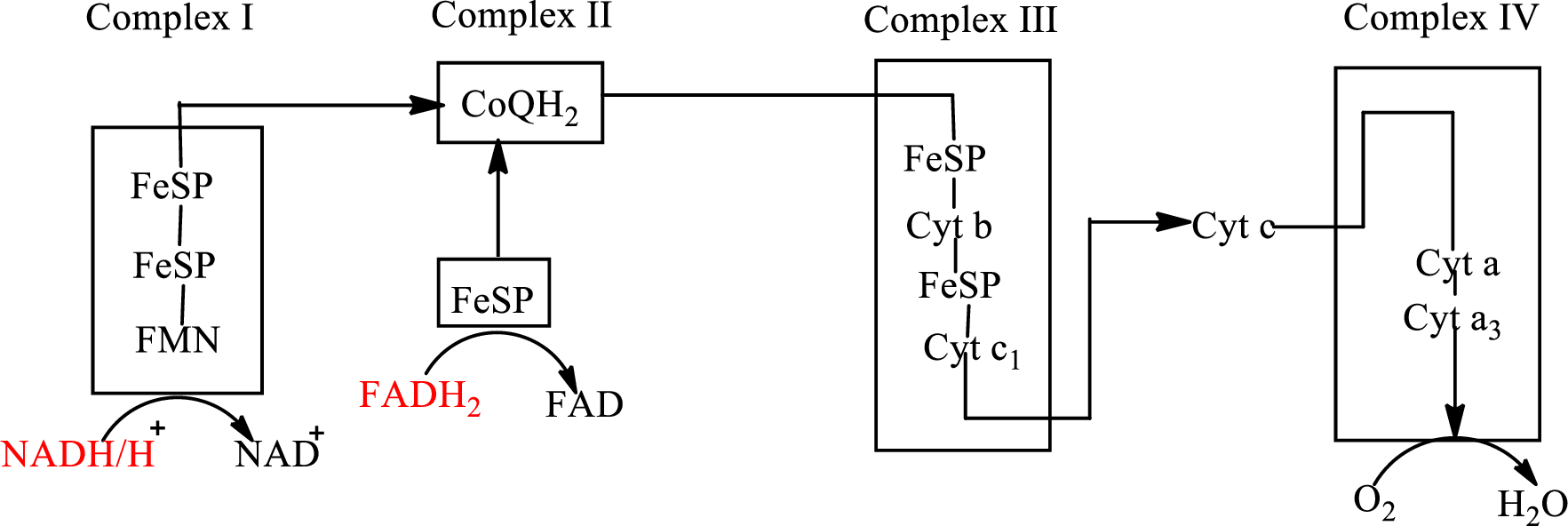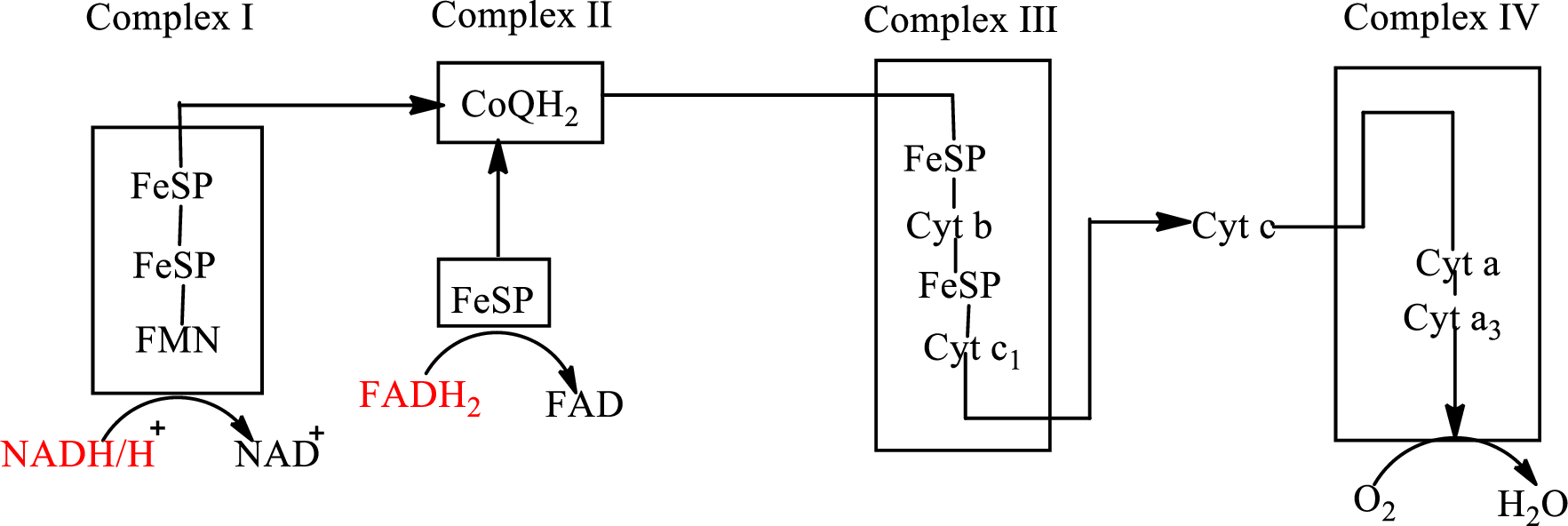
Concept explainers
(a)
Interpretation: To identify the step of the citric acid cycle in that ATP-precursor-molecule is generated that enter the ETC at enzyme complex I.
Concept introduction: Citric acid cycle is the third stage of the biochemical energy production process. The cycle includes the reactions in which the acetyl part of acetyl CoA is oxidized and leads to the formation of carbon dioxide and
Electron transport chain is a sequence of biochemical reactions in which electrons and hydrogen atoms from the citric acid cycle are transferred to various intermediate carriers and finally reacts with molecular oxygen to form a water molecule. The reaction of the formation of the water is:
The electron transport chain is as follows:

NADH is the reduced form of nicotinamide adenine dinucleotide. It is employed as an oxidizing agent in various reactions like oxidation of secondary alcohol into a
(b)
Interpretation: To identify the step of the citric acid cycle in that ATP-precursor-molecule is generated that enter the ETC at enzyme complex II.
Concept introduction: Citric acid cycle is the third stage of the biochemical energy production process. The cycle includes the reactions in which the acetyl part of acetyl CoA is oxidized and leads to the formation of carbon dioxide and
Electron transport chain is a sequence of biochemical reactions in which electrons and hydrogen atoms from the citric acid cycle are transferred to various intermediate carriers and finally reacts with molecular oxygen to form a water molecule. The reaction of the formation of the water is:
The electron transport chain is as follows:

FADH2 is the reduced form of flavin adenine dinucleotide. The main function of flavin adenine dinucleotide is to act as an oxidizing agent and used by the cell in oxidation reactions like oxidation of fatty acid.
(c)
Interpretation: To identify the step of the citric acid cycle in that ATP-precursor-molecule is generated that does not enter the ETC.
Concept introduction: Citric acid cycle is the third stage of the biochemical energy production process. The cycle includes the reactions in which the acetyl part of acetyl CoA is oxidized and leads to the formation of carbon dioxide and
Electron transport chain is a sequence of biochemical reactions in which electrons and hydrogen atoms from the citric acid cycle are transferred to various intermediate carriers and finally reacts with molecular oxygen to form a water molecule. The reaction of the formation of the water is:
The electron transport chain is as follows:

Want to see the full answer?
Check out a sample textbook solution
Chapter 12 Solutions
Organic And Biological Chemistry
- Lactate dehydrogenase catalyzes the following equilibrium reaction in both liver and muscle cells: pyruvate+NADH+H+lactate+NAD+ In terms of equilibrium, explain why lactate must be removed from muscle cells under anaerobic conditions and why lactate does not accumulate in the liver under these conditions. Hint: Think of the Cori cycle.arrow_forwardWhy are so many different enzymes needed?arrow_forwardThe first step of the metabolic process known as glycolysis is the conversion of glucose to glucose- 6-phosphate. This process has a positive value for rG' Glucose + Pi Glucose-6-phosphate + H2O rG' = +13.8 kJ/mol-rxn This reaction is coupled to the hydrolysis of ATP ATP + H2O ADP + Pi rG' = -30.5 kJ/mol-rxn What is the sum of these two equations and the value of rG' for the coupled reaction? Is the coupled reaction product-favored at equilibrium?arrow_forward
- Based on the graphical information in Problem 21-41 about enzymes A and B indicate whether the enzyme activity of enzyme B increases or decreases when the following changes in reaction conditions are made. a. pH decreases from 7.6 to 7.2 b. pH increases from 7.2 to 7.4 c. temperature decreases from 37.8C to 37.6C d. temperature increases from 38.2C to 38.4Carrow_forwardExplain how the pasteurization of milk utilizes one of the factors that influence enzyme activity.arrow_forwardCLASSIFY THE FOLLOWING ENZYMES1. Aspartate 2. Cellulase3.Aspartate aminotransferasearrow_forward
- Classify ther following enzyme ? Lactasearrow_forwardWhich of the following enzymes is found in blood serum and is diagnostic of prostate cancer if enzyme levels are elevated? A.alanine aminotransferase B.phosphohexose isomerase C.lactate dehydrogenase D.acid phosphatase E.alkaline phosphatasearrow_forwardThe enzyme d-amino acid oxidase has avery high turnover number because the d-amino acids are potentially toxic. The KM for the enzyme is in the range of 1 to2 mM for the aromatic amino acids and in the range of 15 to20 mM for such amino acids as serine, alanine, and the acidicamino acids. Which of these amino acids are the preferred substrates for the enzyme?arrow_forward
- Give the name of the enzyme that will most likely catalyze each of the following reactions: O CH3 - CH2 - OH + NAD+ → CH3 – C – H + NADH + H+ Ans. ___________________________________________ CH3 – C – COOH + R – CH – COOH → CH3 – CH – COOH + R – C – COOH O NH2 NH2 O HO – C – CH – CH2 – C – OH → HO – C – CH = CH – C – OH + H2O O OH O O O CO2 + CH3 – C – C – OH + ATP → HO – C – CH2 – C – C – OH + ADP + Pi O O O O…arrow_forwardWhich best describes the role of enzymes in a chemical reaction? A. They lower the activation energy in the reaction. B. They prevent the reaction from occurring. C. They are produced by the reaction. D. They are consumed by the reaction.arrow_forwardChemistry What is the main aspect that the enzymes succinyl-CoA synthetase, pyruvate kinase, and phosphoglycerate kinase have in common?arrow_forward
 Organic And Biological ChemistryChemistryISBN:9781305081079Author:STOKER, H. Stephen (howard Stephen)Publisher:Cengage Learning,
Organic And Biological ChemistryChemistryISBN:9781305081079Author:STOKER, H. Stephen (howard Stephen)Publisher:Cengage Learning, General, Organic, and Biological ChemistryChemistryISBN:9781285853918Author:H. Stephen StokerPublisher:Cengage Learning
General, Organic, and Biological ChemistryChemistryISBN:9781285853918Author:H. Stephen StokerPublisher:Cengage Learning Introductory Chemistry: A FoundationChemistryISBN:9781337399425Author:Steven S. Zumdahl, Donald J. DeCostePublisher:Cengage Learning
Introductory Chemistry: A FoundationChemistryISBN:9781337399425Author:Steven S. Zumdahl, Donald J. DeCostePublisher:Cengage Learning Chemistry for Today: General, Organic, and Bioche...ChemistryISBN:9781305960060Author:Spencer L. Seager, Michael R. Slabaugh, Maren S. HansenPublisher:Cengage Learning
Chemistry for Today: General, Organic, and Bioche...ChemistryISBN:9781305960060Author:Spencer L. Seager, Michael R. Slabaugh, Maren S. HansenPublisher:Cengage Learning Chemistry & Chemical ReactivityChemistryISBN:9781337399074Author:John C. Kotz, Paul M. Treichel, John Townsend, David TreichelPublisher:Cengage Learning
Chemistry & Chemical ReactivityChemistryISBN:9781337399074Author:John C. Kotz, Paul M. Treichel, John Townsend, David TreichelPublisher:Cengage Learning Chemistry & Chemical ReactivityChemistryISBN:9781133949640Author:John C. Kotz, Paul M. Treichel, John Townsend, David TreichelPublisher:Cengage Learning
Chemistry & Chemical ReactivityChemistryISBN:9781133949640Author:John C. Kotz, Paul M. Treichel, John Townsend, David TreichelPublisher:Cengage Learning





